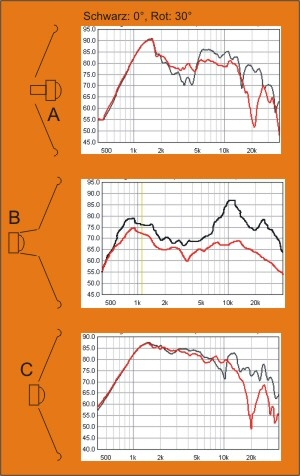[Products]
[Press + Media]
[Basics]
[Technology]
[Application]
[Shop]
[FAQ]
[Contact]
[Links]
[Site Notice]
If the coaxial principle can be superior to discrete constructions, we have to think about how to build such a system to exploit totally the benefits while minimizing the disadvantages - completely. In the last few decades some designs developped, partly because of costs, partly constructed under sound criteria.
In electrodynamic coaxial speakers there are basically 3 different types of design. They keep their characteristic features (regardless of manufacturer and model series), although we have different intensities and different forms. The frequency representations show exemplary this particular characteristic and they were taken over by very good specimens of their species.
|
A: The tweeter is situated in front of the woofer cone, either mounted on a pedestal or fixed in a grille. This design is often found in very simple and cheap constructions, often in car hi-fi range.By positioning, the high-frequency sound rushes ahead of the woofer, temporal coherence is not present. Another disadvantage is its highly rugged environment for the tweeter, which leads to strong interferences. Advantages are the cost structure and the fact that the tweeter has not to be so small mechanically that it fits into the voice coil of the woofer. B: The high-frequency driver is placed behind the woofer-motor and emits, usually trough some kind of horn or waveguide, by this and often a permeable dustcap. Überwiegend bei leistungsstarken Treibern für den Beschallungebereich anzutreffen, liegen auch hier die Schallzentren von Hoch- und Tieftöner nicht auf einer Ebene. Der Hochtöner eilt nach - keine zeitliche Kohärenz. Mainly found in powerful drivers for PA, the acoustical centers of tweeter and woofer are not on one level. The tweeter is coming to late - no temporal coherence.Because of the close limits of the woofer motor there is no ideal configurable horn course and because of the also not ideal extension of this horn through the woofer cone, in generally we have the result of a very restless frequency response with a number of resonances and delayed decay behaviour.Advantage is the high sensitivity of the tweeter, which allows enormous maximum level. This however to the disadvantage of the acoustic quality. C: The tweeter driver is located in the voice coil of the woofer This design is the only one that allows conformity of the acoustic centers of the two drivers. The sound components of the tweeter and the woofer are emitted simultaneously, enabling a superior spatial location. That’s the reason why this design comes next to the ideal of the point source. In addition, pursuant to that agreement, this arrangement has also a better behaviour at angles – Condition for the effective work of the crossover. But however, here also we have the disadvantage, of the most highly rugged environment for the tweeter, which leads to interferences and therefore peaks and dips in frequency response. This effect is most significant on axis and is mostly improving under angles. Here he have already a sharp drop to the heights, so we have to make deductions in the high-tweeter area |
|
IOverall, this design has the best conditions for an audiophile and realistic scan of music that doesn´t mean, it couldn´t be made better.Starting points for a clear optimization offers this particular environment of the tweeter
If it would be possible to make this more evenly and reduce its impact on the tweeter, and if both components were created and made on high quality, it´s possible to use the advantages of this design much more better and reduce its disadvantages to a minimum or even eliminate them totally.
Copyright(c) 2018 Audio Consequence. Alle Rechte vorbehalten.
